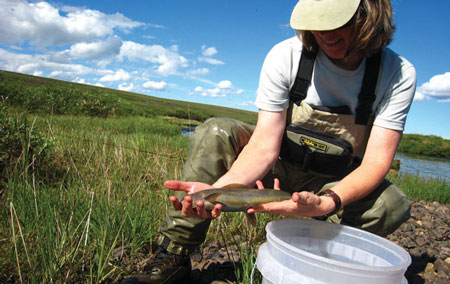An EZ-Pass for Fish: How a Fast-Warming Arctic Affects Migration and Survival

The Arctic grayling may look—well, just plain old gray, but for Linda Deegan it’s a “beautiful fish” for many reasons besides being tasty. The grayling is one of very few fish that spends its entire life, including the frigid winter, in Arctic Alaska. To solve the mystery of how they cope, Deegan, a senior scientist in the MBL Ecosystems Center, began tracking the migration patterns of Arctic grayling in 1990. Her growing database focuses on the fish that congregate in summer in the insect-rich Kuparuk River near Toolik Lake, and then migrate upstream before the river freezes solid to deep, cold Green Cabin Lake, where they overwinter.
Today, Deegan’s grayling database has proven very useful for understanding the impact of a warming climate on an animal’s behavior—in this case, the grayling’s ability to migrate up drier riverbeds, survive the winter, and reproduce in the spring. Temperatures have warmed an average 3 to 5 degrees F in the Arctic over the past century, affecting when rivers freeze and flow and their interconnections across the landscape.
This documentary video series, produced by FrontierScientists, illuminates Deegan’s “Fishscape” project and the research it has spawned in other scientists. The first video describes the ingenious river monitoring system—kind of like EZ-Pass toll booths on the highway—that Deegan has set up to automatically “count” tagged grayling as they migrate along rivers. The narrator is Heidi Golden, who was an MBL research assistant with Deegan for more than a decade and is now a Ph.D. candidate at the University of Connecticut with Deegan.
https://www.youtube.com/watch?v=vUA7ZTjLxpU
In the next video, F. Jeffrey Adams, a biologist with the U.S. Fish and Wildlife Service, discusses the endangered status of the grayling in some parts of the United States. Heidi Golden explains her research to identify genetically distinct populations (“genetic clusters”) of Arctic grayling near the Kuparak River. Will these clusters become further isolated across a warmer, dryer Arctic aquatic landscape?
https://www.youtube.com/watch?v=_HDTOpTH5sE
By studying the “young of the year,” the smallest grayling, Golden is asking whether additional genetic sub-clusters exist when grayling spawn at multiple sites along the river.
https://www.youtube.com/watch?v=67kppS4tLAs
In “Grayling Otolith Signal,” Golden reveals how a small bone in the fish’s inner ear can be read like tree rings, revealing where the fish has lived at different stages of its life.
https://www.youtube.com/watch?v=MyaewCvX5xg
Are there any grayling “hiding” in overwintering lakes that have yet to be discovered? To get a good picture of what is happening to the species at the landscape level, scientists need to know where all of their niches may be.
https://www.youtube.com/watch?v=qsWxauWBOEk
This research is funded through the National Science Foundation, the Arctic Long Term Ecological Research Network, U.S. Fish and Wildlife Service, the U.S. Environmental Protection Agency (EPA-STAR Fellowship), and the University of Connecticut. Logistic and technical support provided by the Marine Biological Laboratory, Woods Hole Oceanographic Institute, the University of Alaska Fairbanks, and Toolik Field Station.
